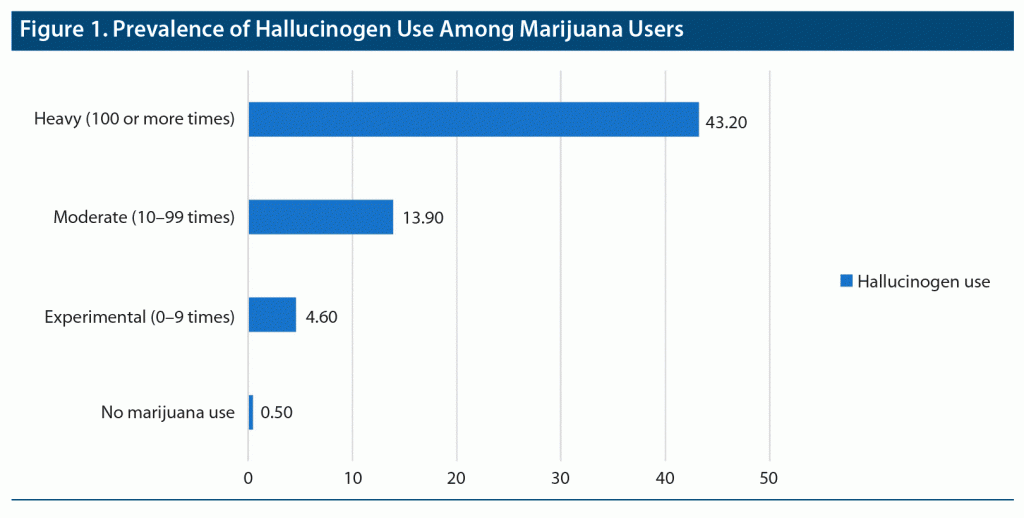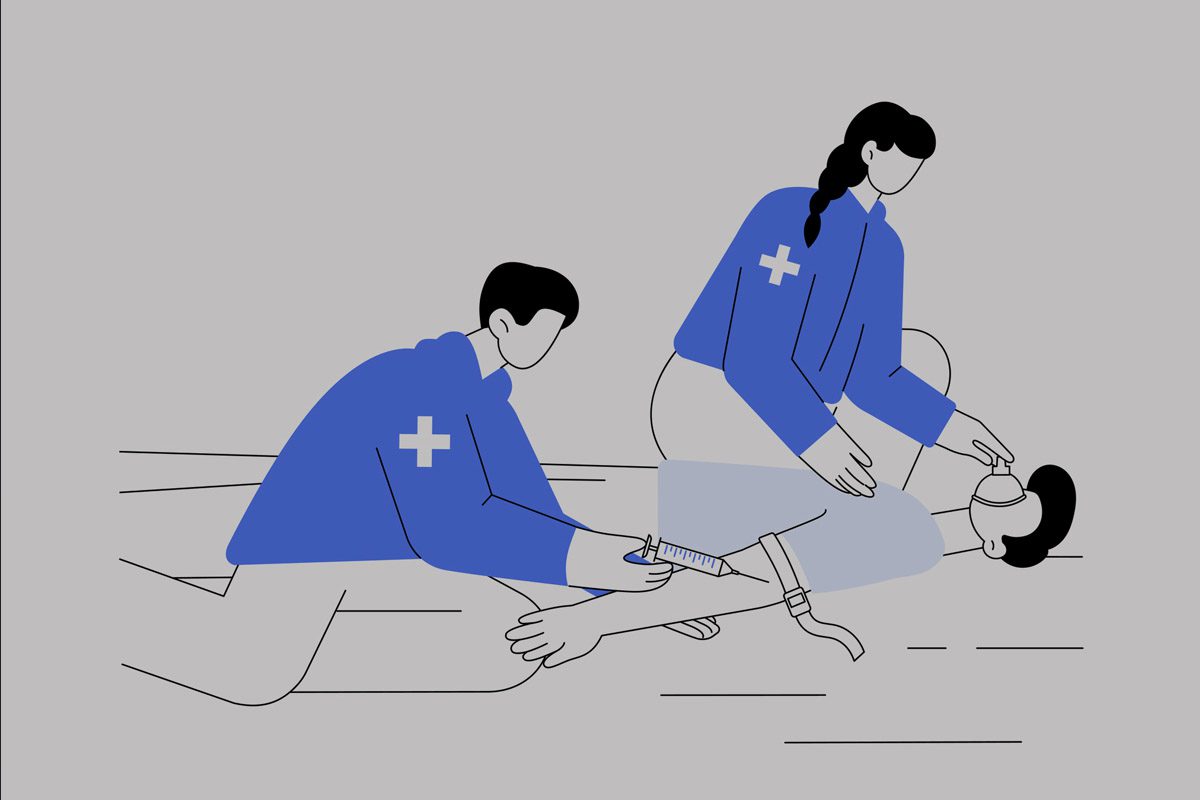
Prim Care Companion CNS Disord 2022;24(5):21br03204
To cite: Desai S, Kulkarni N, Gandhi K, et al. The link between marijuana and hallucinogen use among US adolescents. Prim Care Companion CNS Disord. 2022;24(5):21br03204.
To share: https://doi.org/10.4088/PCC.21br03204
© 2022 Physicians Postgraduate Press, Inc.
aDepartment of Psychiatry, One Brooklyn Health-Brookdale University Hospital Medical Center, Brooklyn, New York
*Corresponding author: Saral Desai, MD, One Brooklyn Health-Brookdale Hospital, 1 Brookdale Plaza, Brooklyn, NY 11203 ([email protected]).
Cannabis is the most commonly used recreational substance in the United States after alcohol and tobacco.1 Its use dwarfs that of cocaine, stimulants, hallucinogens, and opioids combined. A change in the national perception has resulted in the legalization of cannabis in 18 states and counting.2 At the same time, the renewed societal interest in hallucinogen use for recreational and health care purposes has led to a rise in concurrent use of cannabis and hallucinogens.3,4 Our first objective is to assess the prevalence of cannabis use among US adolescents. Next, we will study the prevalence of hallucinogen use among US adolescents in combination with cannabis use. Lastly, we will attempt to identify whether intensity of use is correlated between the 2 illicit substances among US adolescents.
METHODS
A retrospective analysis of the Centers for Disease Control and Prevention’s Youth Risk Behavior Surveillance System (YRBSS) 2019 data5 was conducted and included candidates that were subsequently divided into 3 subgroups based on frequency of use: (A) experimental users (0–9 times), (B) moderate users (10–99 times), and (C) heavy users (100 or more times). Hallucinogen (LSD, acid, PCP, angel dust, mescaline, or mushrooms) use was identified with the survey questions from the YRBSS database. Univariate analysis and multivariable survey logistic regression analysis were used to identify the odds of hallucinogen use among participants in Groups A, B, and C after adjusting for age, sex, race, alcohol, cigarette, e-cigarette, synthetic cannabis, cocaine, heroin, pain medication, steroids, ecstasy, inhalants, methamphetamine, and injection drug use.
RESULTS
A total of 12,548 participants were included, of which 16.8% were in Group A, 11.2% were in Group B, and 8.8% were in Group C. Compared to participants with no cannabis use, the prevalence of lifetime hallucinogen use was significantly higher in Group C (heavy cannabis users), followed by Group B and Group A (43.2% vs 13.9% vs 4.6% vs 0.5%; P < .0001). Figure 1 shows the prevalence of hallucinogen use in varying intensity of marijuana users. In the regression analysis, a stepwise increase in the intensity of cannabis use from Group A (adjusted odds ratio [aOR] = 4.8; 95% CI, 2.3–10.1; P < .0001) to Group B (aOR = 10.9; 95% CI, 4.9–24.1; P < .0001) to Group C (aOR = 37.8; 95% CI, 15.9–90.0; P < .0001) was associated with a similar increase in the odds of concurrent hallucinogenic drug use.
DISCUSSION
An increase in the intensity of marijuana use is shown to be associated with higher odds of hallucinogen use in the US adolescent population. The findings of our study provide further evidence of the association between marijuana use and hallucinogen use. The results of our study also contribute to the understanding of the effects of marijuana on various health risk behaviors that may be directly or indirectly mediated by the increased odds of using other substances such as hallucinogens. Given the rising popularity of both substances among adolescents and potential adverse neurocognitive effects on the developing brain,6 further research should be conducted to understand the link between cannabis and hallucinogen use, and appropriate prevention policies should be implemented to improve adolescent health.
Wilcox et al7 reported marijuana users had higher exposure opportunities to hallucinogens, and these people were more likely to continue using hallucinogens compared to nonmarijuana users. However, results of our study suggest that after controlling for use of other substances, marijuana users are uniquely at higher odds of hallucinogen use based on the intensity of marijuana use, suggesting a unique neurobiological mechanism that requires further investigation.
Submitted: November 30, 2021; accepted February 7, 2022.
Published online: August 30, 2022.
Relevant financial relationships: None.
Funding/support: None.
References (7)

- NIDA. What is the scope of marijuana use in the United States? National Institute on Drug Abuse website. Accessed November 12, 2021. https://www.drugabuse.gov/publications/research-reports/marijuana/what-scope-marijuana-use-in-united-states
- Pacula RL, Smart R. Medical marijuana and marijuana legalization. Annu Rev Clin Psychol. 2017;13(1):397–419. PubMed CrossRef
- Yockey RA, Vidourek RA, King KA. Trends in LSD use among US adults: 2015–2018. Drug Alcohol Depend. 2020;212:108071. PubMed CrossRef
- Begola MJ, Schillerstrom JE. Hallucinogens and their therapeutic use: a literature review. J Psychiatr Pract. 2019;25(5):334–346. PubMed CrossRef
- Centers for Disease Control and Prevention. Youth Risk Behavior Surveillance Center. Accessed November 12, 2021. https://www.cdc.gov/healthyyouth/data/yrbs/index.htm
- Mandelbaum DE, de la Monte SM. Adverse structural and functional effects of marijuana on the brain: evidence reviewed. Pediatr Neurol. 2017;66:12–20. PubMed CrossRef
- Wilcox HC, Wagner FA, Anthony JC. Exposure opportunity as a mechanism linking youth marijuana use to hallucinogen use. Drug Alcohol Depend. 2002;66(2):127–135. PubMed CrossRef
Enjoy this premium PDF as part of your membership benefits!
Save
Cite




